CCG, IOM Jointly Releases Chinese Version of World Migration Report 2015
June 05 , 2019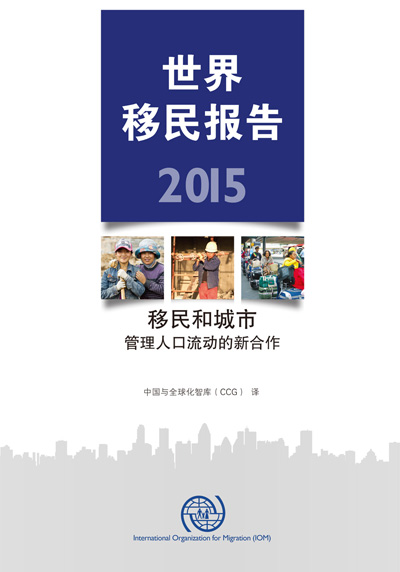
On March 17, 2016, The Center for China and Globalization and International Organization for Migration jointly launched the Chinese version of the World Migration Report 2015. The annual report lays out the latest trends in global migration, analyzes the connections between migration and urban diversity, and discusses many other issues related to migration and social and economic development.
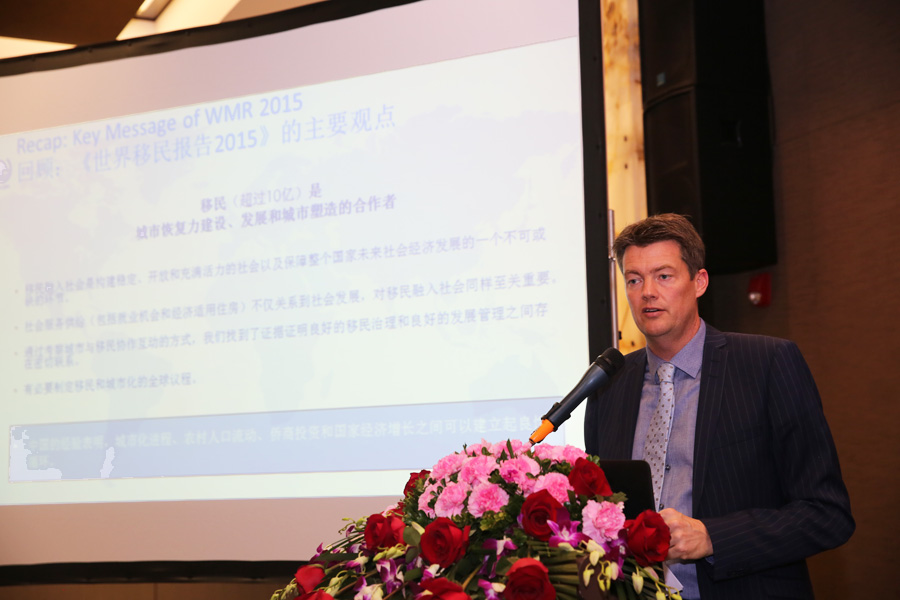
Par Liljert, IOM Representative to China
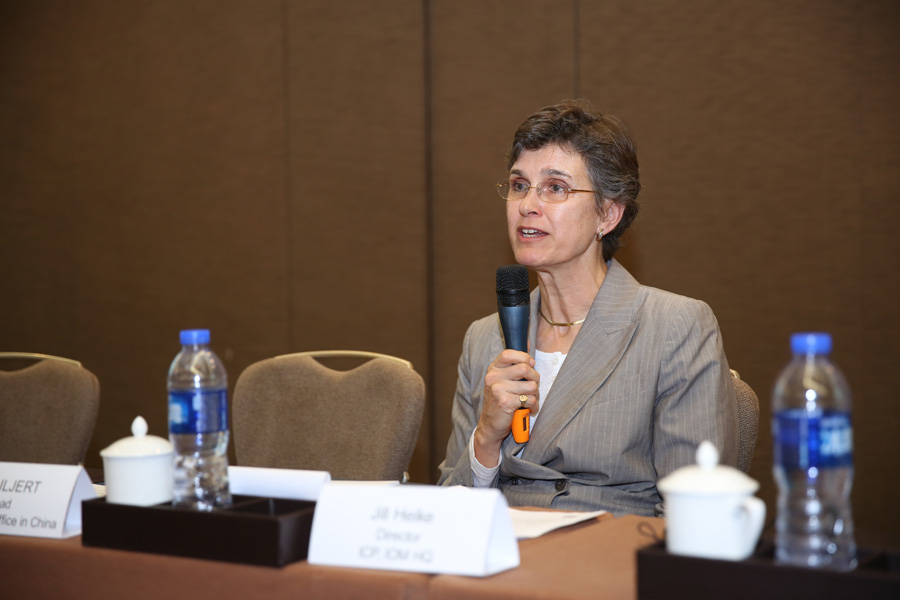
Jill Helke, Director of International Cooperation & Partnerships Department of IOM

Wang Huiyao, CCG President
The launching ceremony was hosted by IOM Representative to China Par Liljert. Jill Helke from IOM’s Department of International Cooperation & Partnerships and CCG President Wang Huiyao delivered presentation on behalf of their respective organizations.
The new book, titled “Migrants and Cities: New Partnerships to Manage Mobility,” is the 8th report in IOM’s World Migration Report series. It focuses on urban migration, reviewing how it is shaping cities, while also discussing in detail the lives immigrants who have moved to these metropolises. This book marks the second time that CCG and IOM have joined hands to publish an influential report on migration issues in China.
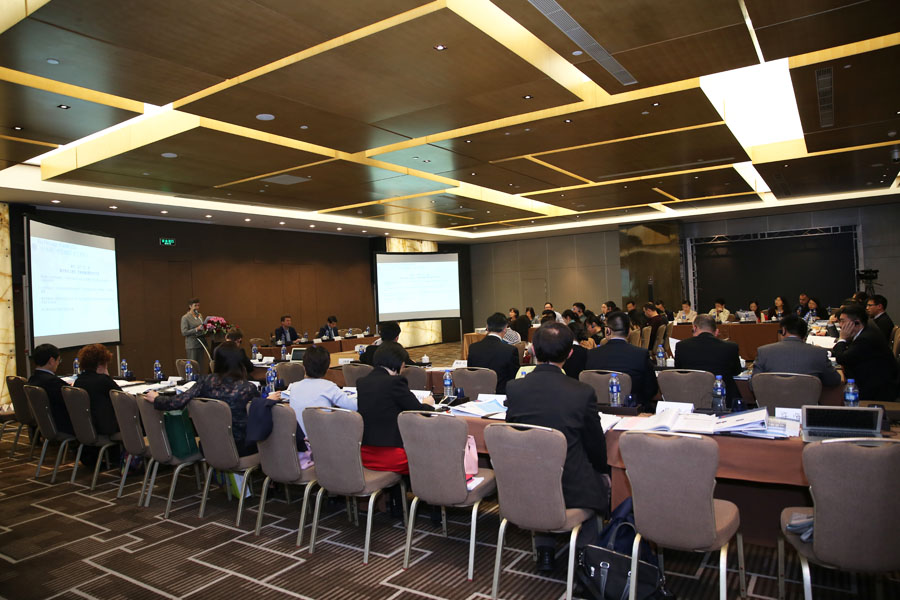
Much of the current international discussion about migration trends and migration policy is focused on the national level. This report, by contrast, takes a micro-level view, analyzing the large-scale movement of people to cities with the aim of improving our understanding of the local socioeconomic dynamics of migration and the close connection between it and urban development. The report also puts forward recommendations on policymaking for sustainable urban development and inclusion of migrants’ issues in the discussion of urbanization issues. These features make it an important contribution to devising a post-2015 global development framework.
The main chapters of the World Migration Report 2015 investigate both the challenges and opportunities increased migration creates in different urban settings. These chapters present findings on the potential benefits of all forms of migration and mobility for the growth and development of cities. The report showcases innovative ways in which migration and urbanization policies can be better designed to benefit both migrants and cities. The report pays particular attention to the living conditions for urban migrants in the global South, thereby providing a useful corrective to the current focus on cities in the global North. It highlights how cities and migrants can work together in order to reduce the risks of migration to cities and take advantage of growing urban diversity in areas such as community resilience building and local economic, social and cultural development through leveraging the connections of migrants between places of origin and host communities.
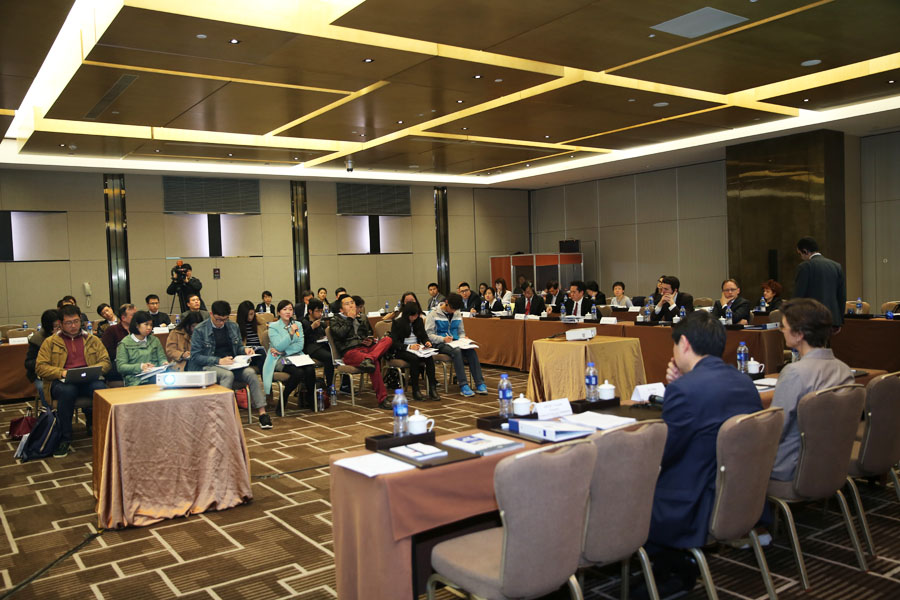
Prior to the launching ceremony, CCG held a seminar on migration and urban policies to discuss the global trends in urbanization and migration, opportunities and challenges in managing mobility, and importance of forging partnerships to manages that mobility. The participants included representatives from the Chinese Government Ministry of Foreign Affairs, Ministry of Human Resources and Social Security, Bureau of Exit and Entry Administration of the Ministry of Public Security, State Administration of Foreign Experts Affairs, and Guangzhou municipal government. The seminar also attracted foreign guests from the International Labor Organization, EU delegation to China and Milan municipal government.
Latest Trends in Global Migration
· About 50% of international migrants reside in ten highly urbanized, high-income countries
According to the statistics in the report, there are an estimated 232 million international migrants and740 million internal migrants in the world. About 50% of international migrants reside in ten highly urbanized, high-income countries, namely Australia, Canada and the United States, several countries in Europe (France, Germany, Spain and the United Kingdom), the Russian Federation, Saudi Arabia and the United Arab Emirates. Almost all of the growth in the world’s population over the next few decades, another 2.5 billion, is expected to be in urban areas in low- and middle-income countries, particularly in Africa and Asia.
· New growth centers attract more and more migrants
According to the report, the geography of migration flows is changing as new destinations emerge globally. In addition to the traditional migrant corridors from the Global South to the advanced economies of North America and Europe, migrants are attracted to the fast-growing economies of new growth centers in East Asia, South Africa, Brazil and India. Population movements among low- and middle- income countries, known as South–South migration, have gained importance with developing countries themselves becoming places of both immigration and emigration. Internal migration is also on the rise in these countries and is leading to the fast expansion of cities. New migrant destinations are also emerging at subnational level as migrants move to smaller, second-tier metro areas.
· Three million people move to cities every week around the world
Statistics show that over 54% of people across the globe were living in urban areas in 2014. The current urban population of 3.9 billion is expected to grow to some 6.4 billion by 2050. Three million people move to cities every week around the world.
· Number of megacities rises to 28
Today, the number of megacities with more than 10 million inhabitants has nearly tripled to 28 from a mere ten in 1990, with 453 million inhabitants, accounting for 12% of the world’s urban dwellers.Large cities with 5 to 10 million inhabitants account for a small, but growing proportion of the global urban population. In 2014, just over 300 million people lived in large cities, currently accounting for 8% of the urban population of the world. Between 1990 and 2004, the global population living in medium-sized cities with 1 to 5 million inhabitants nearly doubled and is expected to increase by another 36% between 2014 and 2030, growing from 827 million to 1.1 billion. The number of people living in cities of between 500,000 and 1 million inhabitants is expected to hold only around 10% of the global urban population. In 2014, close to one half of the world’s urban population lives in settlements with fewer than 500,000 inhabitants. While this proportion is projected to shrink over time, by 2030 these small cities and towns will still be home to around 45% of urban dwellers.
· Emergency of new forms of migration leads to rapid change in migration
The emergence of new forms of migration, mobility, networking and social media across national borders has led to a rapid change in the population structure and interactions between individuals and social groups in cities. Urban life in many cities today is therefore characterized by the presence of immigrant groups or longstanding ethnic and racial differentiations, often accompanied by inequality and segregation. The presence of smaller, less organized, legally differentiated and non-citizen immigrant groups in some cities of developed countries is known as “super-diversity”which questions the validity of the existence of a sociocultural homogeneous “majority society” as opposed to “migrant others”. The following figure shows the scale of diversity in London today.
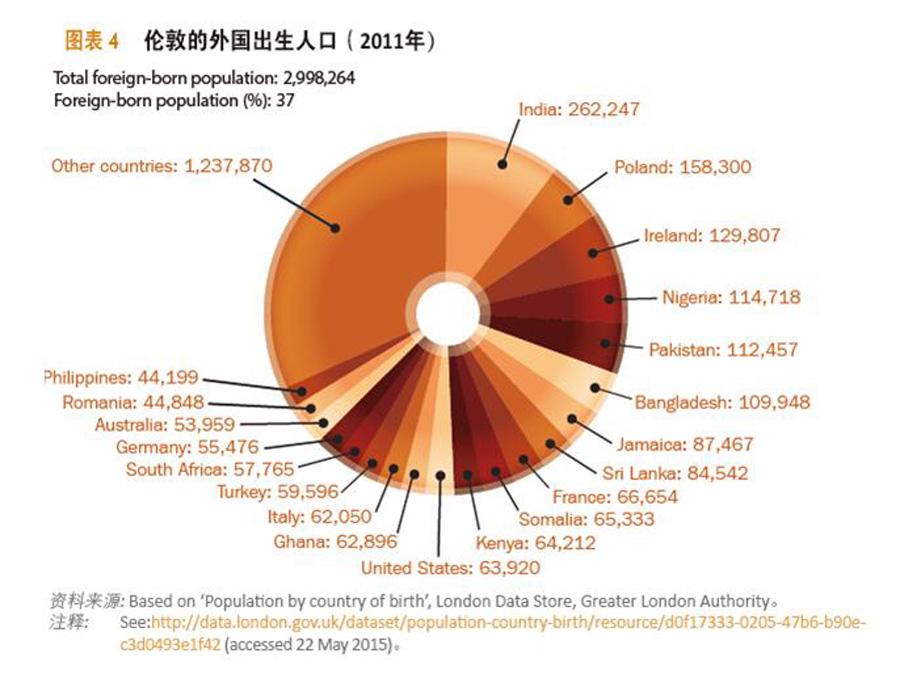
· 20% of world foreign-born population resides in established cities
Nearly one in five of the world foreign-born population resides in established global gateway cities. In many of these cities such as Sydney, London and New York, migrants represent over a third of the population and, in some cities such as Brussels and Dubai, migrants account for more than half of the population. Other cities have seen a remarkable growth in migration in recent years. For example, the number of foreign residents in Seoul has doubled in the last ten years. In Asia and Africa, rapidly growing small cities are expected to absorb almost all the future urban population growth of the world and this mobility pattern to cities and urban areas is characterized by the temporality and circularity of the internal migration process.
The following figure shows the size of the foreign-born population in major world cities; some cities with highly mobile workforces have particularly high proportions of foreign-born populations, for instance, Dubai (83%) or Brussels (62%) which is the headquarters of the European Commission.
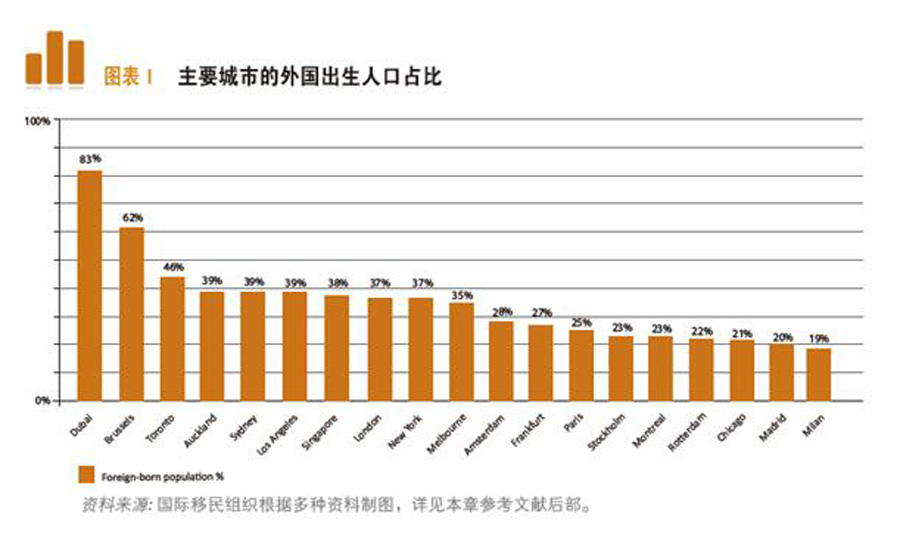
· Size of foreign-born population in China still relatively very small but growing
Every day an estimated 120,000 people migrate to cities in the Asia-Pacific region and, by 2050, the proportion of people living in urban areas is likely to rise to 63%. The Asia-Pacific region has added nearly 1 billion people to its urban population between 1990 and 2014, about half of whom in China alone (450 million). The phenomenon is part of a long-term trend. The urban population of the region more than doubled between 1950 and 1975 and again between 1975 and 2000 and is projected to almost double once more between 2000 and 2025.
The following table sets out the percentage of the foreign-born population living in major cities in the Asia–Pacific region. Singapore has the highest proportion with 34.7% of the work force foreign-born and 38% of the resident population. Other statistics show that rates are increasing; for instance, the number of foreign residents in Seoul, Republic of Korea, has doubled in the last ten years from 114,685 in 2004 to 263,678 in 2014. Japan has over 2.1 million foreign nationals residing in the nation’s urban areas and cities like Kuala Lumpur and Bangkok are home to significant numbers of foreign nationals.
In China, the size of the foreign-born population is still relatively very small but is growing as multinational corporations relocate to cities and transfer their multinational workers in and out of China. Between 2000 and 2013, China’s overall international migrant stock increased by more than fifty per cent as its fast-growing economy attracts foreign professionals. Chinese expatriates are also drawn back as its cities grow and provide better living and work prospects, and opportunities for investment, entrepreneurship and careers with multinational companies. Chinese cities are also competing among themselves to attract overseas Chinese talents with various incentives.
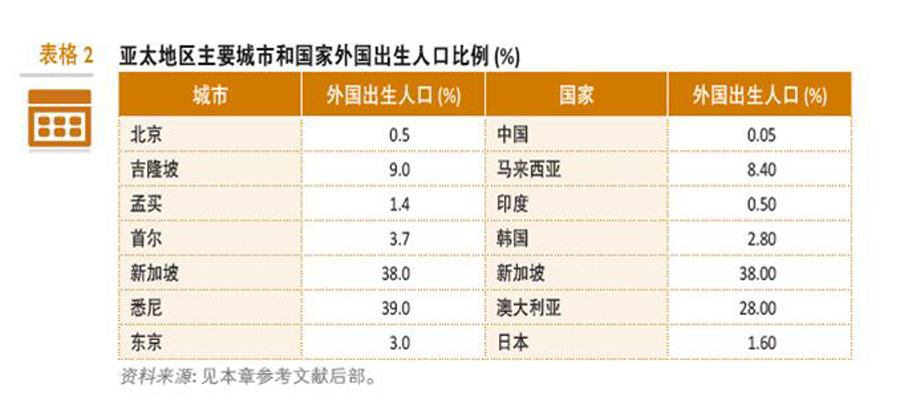
· Internal migration is shaping urban growth and diversity
Internal migration is shaping urban growth and diversity around the world in different ways. In Asia, for example, about 47% of its population now lives in urban areas. This number has almost doubled since 1970 and represents a profound change in the way people live, work and interact. The way internal migration to cities is managed will be critical to the economic and political development of the region. Internal migrants in India account for some 30% of the total population, with estimates ranging from 309 million to 326 million according to the National Sample Survey 2007–2008. China has more than 220 million internal migrant workers (one sixth of its population) according to the 2010 census. The process of urban development is more complex than a simple redistribution of people and involves new mobility strategies of different groups of migrants.
· India’s urbanization rate higher than global average
India has low urbanization levels relative to the rest of the world; 31% of its population was living in urban areas according to the 2011 census compared to 51% globally in the same period. However, the urbanization rate at 1.1% is higher than the global average (0.9%); its urban population is likely to reach 410 million in 2014 and then double to 814 million by 2050.
India has 25 of the 100 fastest-growing cities in the world and cities like Mumbai, Delhi and Kolkata are among the 10 most populous urban areas on the planet. A significant source of this growth is rural-to-urban migration as people move in search of economic opportunities. The proportion of in-migrants among these fastest-growing cities varies from less than 15% in Allahabad and Agra to 55% and over in Surat, Ludhiana and Faridabad. About 45% of the population of Mumbai and of Delhi was comprised of migrants in 2001. The proportion of migrants across these cities is closely related to the economic position and vibrancy of these cities.
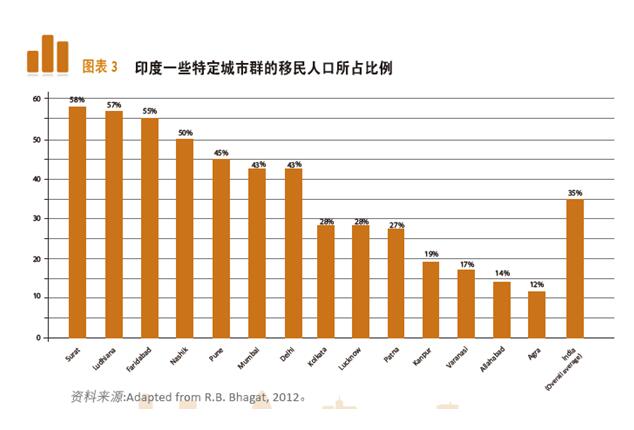
· Urbanization in China unprecedented in scale
Urbanization in China over the last three decades has been unprecedented in scale: 260 million migrants have moved to cities from rural areas, driving much of the country’s rapid economic growth. Between 2000 and 2010 alone, 117 million Chinese moved from rural to urban areas to seek better employment opportunities. Coastal regions, the engines of China’s growth, accounted for more than half of migrant inflows. The largest and fastest-growing internal migrant populations are in the Beijing, Dongguan, Guangzhou and Shanghai metropolitan regions, with more than 52 million migrants in 2010, or 35 per cent of all migrants in China.
Currently, China’s vast migrant population makes up almost one-third of the urban total of 730 million. These migrants, however, face difficulty in gaining official recognition as city-dwellers and are excluded from welfare benefits and access to public services. By 2030, China’s cities will be home to close on 1 billion people or about 70 per cent of the population, compared with 54 per cent today.
Millions of people in China are circular migrants or commuters; they spend much of their time earning a living in large cities whilst leaving family members, especially children, behind in rural areas or small towns. Such mobility patterns and the resulting urban growth has become a new focus among urban scholars and practitioners centering on Asia who estimate that some 119 million people are expected to be added to the peri-urban areas of Asian countries over the next 15 years.
· 90% urban spread takes place in Africa and Asia
Most of the growth in city populations is taking place in low- and middle-income countries, where as many as 66 million people migrate to urban areas each year. The pattern of urban spread varies widely, yet almost 90% taking place in Africa and Asia. China and India will account for more than one-third of the global urban growth in the next 35–40 years. In contrast, the weakest urban population growth will be in Europe.
Migrants Play a Key Role in Urban Governance
The report points out that Migrants make significant and essential contributions to the economic, social and cultural development of their host cities and their communities back home: 1) Migration of people can promote urbanization and hence economic development; 2) Diversity arising from the presence of migrants is shown to increase productivity and be of benefit to urban areas, if strategically managed; 3) Migrants can support development and risk reduction projects in areas of their origin through financial resources, technical expertise or political engagement with other countries. Migrants’ key role in urban governance is also highlighted in the report:
· Migrants are resourceful partners in urban governance: Migrants can be key players in city development, growth, resilience and sustainability. They can be architects and construction workers of growing cities, service providers, entrepreneurs, employers and innovators. As part of the global diaspora, they can facilitate business and humanitarian support between cities and countries. They can contribute to the growing interconnections between cities through sustained global communications, institutional linkages and the exchange of resources among migrants, homelands and wider diasporas.
· Migrants as builders of resilience: Migrants also play an important role in building the resilience of home and host communities through the exchange of resources and support. Migrants and their networks can contribute to managing risk for the community at large. They are often overrepresented in healthy, productive age groups and provide a set of diversified skills that can support disaster preparedness, response and recovery efforts, particularly in ageing societies.
· Migrants as agents of local development: Migrants play a central role in forging the links between cities of origin and destination and in mainstreaming migration into local development planning. City-to-city links are often created or maintained due to the presence of large migrant populations. Migrant and diaspora communities can play an important role in supporting local decentralized development partnerships between cities and in facilitating or undertaking some of the related activities such as the provision of expertise and information on the communities of origin.
· Migrants as city-makers: Migrants can help strengthen the place of cities in the global economic and political hierarchy. They can do so by promoting historical, cultural, religious and socioeconomic assets of a city if given the opportunity.
Migrant-inclusive urban governance is needed
The report points out that cities that seek to strengthen their economic, political and cultural positioning within the global system should draw on the potential opportunities presented by migrant populations living in their communities. Such cities will guarantee migrants the right to cities through inclusive urban public policies and empowered civil society and migrant associations. Specifically, the following suggestions can be made:
· Cities to develop policies for migrant inclusion: Cities need to know and understand migrant communities. Cities not only provide services to migrants but also employ them and facilitate their access to formal labor markets, and encourage the entry of ethnic and migrant-led businesses into supply chains. Most importantly, cities have governance responsibilities and can develop policy frameworks for migrant inclusion in the cities of both origin and destination.
· Urban growth can be sustained when cities invest in their people: Rapid city growth can be difficult to sustain in terms of the impacts on urban infrastructure, environment and social fabric. Cities that are managing these challenges effectively make substantive investments in infrastructure especially in the latest digital technologies. They can empower migrants and provide opportunities that facilitate entrepreneurship. Cities are able to coordinate infrastructure, public services and other operations collaboratively with citizens and the private sector. Engagement often best occurs at the community level where projects can be most efficiently managed and financed.
· Partnerships with migrants and their inclusion are an essential part of urban governance: Urban governance is a collaborative political and policymaking process where individuals and institutions, both public and private, plan and manage the city together. Through the governance process, diverse interests may be accommodated and cooperative action taken. These kinds of partnerships are relevant to migrant inclusion and involve formal institutions as well as informal arrangements which tap into the knowledge, connections and resources of migrants. As such, urban partnership is a critical tool in tackling one of the major urban challenges of our time – the inclusion of large populations of incoming migrants.
· Engaging in partnerships increases social cohesion: Today’s migrant flows are very mixed and cities have to manage growing diversity and cater to internal and international migrants, refugees, labor and irregular migrants alike. Engaging migrants in local partnerships builds trust among the migrants themselves, the city and the host community, and increases migrants’ visibility in the social fabric of the city. While the contribution of migrants to development in their communities of origin has long been recognized, empowering migrants as actors in their cities of destination could also enhance their human and social potential for co-development.
· Engaging in partnerships increases the competitiveness of cities: Cities have become principal actors in global networks of capital and labor. Attracting migrants with appropriate skill levels helps the local economies to be competitive and to meet existing labor shortages and skills needs. Migrant investment in housing, especially in origin communities, and entrepreneurship as well as ethnic/ diaspora tourism all help boost economic gains in cities of origin and destinations.
About IOM
IOM is the leading inter-governmental organization in the field of migration and works closely with governmental, intergovernmental and non-governmental partners. With 157 member states, a further 10 states holding observer status and offices in over 100 countries, IOM is dedicated to promoting humane and orderly migration for the benefit of all. It does so by providing services and advice to governments and migrants. CCG has a long-term cooperative relationship with IOM. The organizations have jointly published a series of study reports and held multiple forums on international talent mobility.






